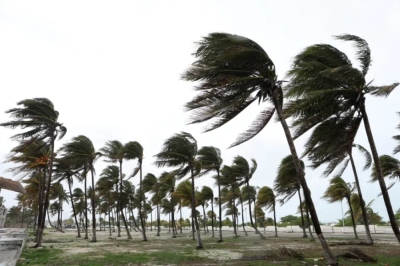
National Flood Insurance Program: One More Short-Term Deadline
The National Flood Insurance Program is one of the programs caught in the wash as the federal government staggers from one short-term budgeting plan to the next.
As the the website of the Federal Emergency Management Agency (FEMA) points out: “Congress must periodically renew the NFIP’s statutory authority to operate. On Sept. 30, 2023, the president signed legislation passed by Congress that extends the National Flood Insurance Program’s (NFIP’s) authorization to Nov. 17, 2023.”
The National Flood Insurance Program is intended to solve a problem: if you live in an flood zone, or want to live in a flood zone, you might prefer to have home insurance. Indeed, you probably can’t get a bank mortgage to buy the property without such insurance. But it’s just a fact that for properties built in certain areas–in zones where floods or wildfires are relatively likely, or on a common pathway for hurricanes–fairly-priced home insurance is going to be quite expensive. In fact, insurance companies may look at such areas and decide that, given the risks, they would prefer not to sell insurance there at all.
But unsurprisingly, the federal flood insurance faces a political imperative not to charge “too much,” so that when floods do happen, there isn’t enough money in the insurance fund to pay for the damages. From 1968 up through the early 2000s, this problem was apparent, but in the context of federal spending, not a huge deal: that is, the accumulated losses of the flood insurance program were in the range of $2-3 billion. But the 205 hurricane season, including Hurricane Katrina, meant that total losses for the program went up into the range of $20 billion.
One can make a case for the government to provide back-up housing insurance. But it’s very hard to make a persuasive case that this insurance should, in effect, subsidize the housing choices of people with homes near the ocean that also happen to be in flood plains.
Thus, since October 2021, FEMA has been trying to raise flood insurance premiums: for an overview and discussion of the of the proposal, see the report from the Government Accountability Office “Flood Insurance: FEMA’s New Rate-Setting Methodology Improves Actuarial Soundness but Highlights Need for Broader Program Reform” (GAO-23-105977, July 31, 2023). FEMA is trying to phase in the rate increases over time, which means that it will take until 2037.
In the meantime, states are suing FEMA to block the rate increases. As the Wall Street Journal reported a couple of months ago (Jean Eaglesham and Katy Steck Ferek, Flood-Insurance Program Faces a Backlash—and a Deadline; Home-purchase closings could be derailed if it lapses, September 21, 2023):
More than 3,000 properties had 10 or more claims from 1978 through 2022, according to FEMA. Nearly two-thirds of those were in five states: Louisiana, Texas, New Jersey, Missouri and New York. … The new pricing will take several years to be fully implemented and result in rate hikes for two-thirds of the program’s 4.7 million policyholders, according to the Government Accountability Office. The states suing FEMA say the new rates could drive people out of flood zones, slam property values and even lead to people losing their homes because they can no longer afford insurance that is a condition of their mortgages. Average annual premiums will eventually more than double in 12 coastal and landlocked states under the revamp …
The complaints from the states are probably realistic. The GAO report suggests that flood insurance could be means-tested–that is, the premium could be capped for those with lower income levels. But this step would then require a permanent subsidy to the flood insurance program. Again, it’s not obvious why federal taxpayers should subsidize home insurance for those living in flood plains.
For a readable overview of these issues, one useful starting point is “Introduction to the National Flood Insurance Program (NFIP)” from the Congressional Research Service (R44593, updated October 16, 2023). Another is “The National Flood Insurance Program: A Primer,” by Zoe Linder-Baptie, Jenna Epstein, and Carolyn Kousky (April 2022, Wharton Risk Management and Decision Processes Center). They point out that standard home insurance policies typically exclude coverage for floods, and 90% of the homes with flood insurance coverage rely on the National Flood Insurance Program. (Technically, private insurance companies write these policies, but the amount charged is set by the federal program, which also holds all of the risk.) There are about 5 million homes with government flood insurance. As they write:
The NFIP is an important program nationwide, providing policyholders with financial resilience in the face of flood risk that is escalating in many locations. But the program faces several challenges. The NFIP is in an unsustainable fiscal position, despite rating overhauls, which will require Congress to forgive its accumulated debt. At the same time, flood insurance policies can be unaffordable for some at-risk residents who most need the financial protection of insurance. …
Currently, the NFIP fails to sufficiently communicate future flood risk, does not a adequately address ever-increasing rainfall-related flooding, flood maps are backward looking and often out-of-date, and has not updated its development regulations to account for this growing risk.
Trending
-
1 UK Tech Sector Secures a Third of European VC Funding in 2024
Azamat Abdoullaev -
2 France’s Main Problem is Socialism, Not Elections
Daniel Lacalle -
3 Fed Chair Jerome Powell Reports 'Modest' Progress in Inflation Fight
Daniel Lacalle -
4 AI Investments Drive 47% Increase in US Venture Capital Funding
Felix Yim -
5 The Future of Work: How Significance Drives Employee Engagement
Daniel Burrus





Comments